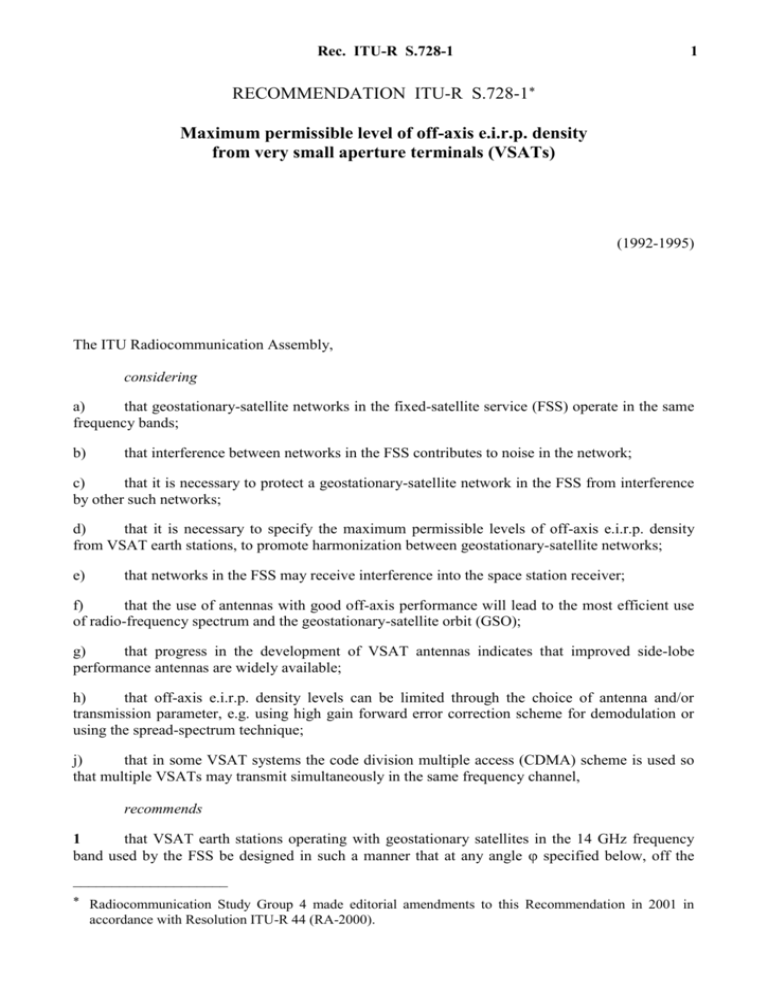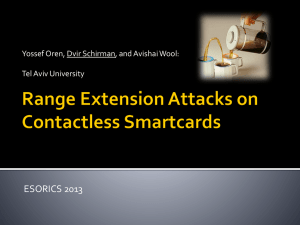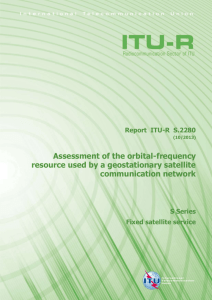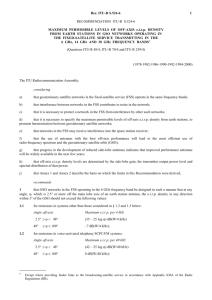Word - ITU
advertisement

Rec. ITU-R S.728-1 1 RECOMMENDATION ITU-R S.728-1* Maximum permissible level of off-axis e.i.r.p. density from very small aperture terminals (VSATs) (1992-1995) The ITU Radiocommunication Assembly, considering a) that geostationary-satellite networks in the fixed-satellite service (FSS) operate in the same frequency bands; b) that interference between networks in the FSS contributes to noise in the network; c) that it is necessary to protect a geostationary-satellite network in the FSS from interference by other such networks; d) that it is necessary to specify the maximum permissible levels of off-axis e.i.r.p. density from VSAT earth stations, to promote harmonization between geostationary-satellite networks; e) that networks in the FSS may receive interference into the space station receiver; f) that the use of antennas with good off-axis performance will lead to the most efficient use of radio-frequency spectrum and the geostationary-satellite orbit (GSO); g) that progress in the development of VSAT antennas indicates that improved side-lobe performance antennas are widely available; h) that off-axis e.i.r.p. density levels can be limited through the choice of antenna and/or transmission parameter, e.g. using high gain forward error correction scheme for demodulation or using the spread-spectrum technique; j) that in some VSAT systems the code division multiple access (CDMA) scheme is used so that multiple VSATs may transmit simultaneously in the same frequency channel, recommends 1 that VSAT earth stations operating with geostationary satellites in the 14 GHz frequency band used by the FSS be designed in such a manner that at any angle specified below, off the ____________________ * Radiocommunication Study Group 4 made editorial amendments to this Recommendation in 2001 in accordance with Resolution ITU-R 44 (RA-2000). 2 Rec. ITU-R S.728-1 main-lobe axis of an earth-station antenna, the maximum e.i.r.p. in any direction within 3° of the GSO should not exceed the following values: Angle off-axis 2 7 33 – 25 log dBW 7 9.2 12 dBW 9.2 48 Maximum e.i.r.p. in any 40 kHz band 48 36 – 25 log dBW – 6 dBW In addition, the cross-polarized component in any direction degrees from the antenna main-lobe axis should not exceed the following limits: Angle off-axis 2 Maximum e.i.r.p.in any 40 kHz band 2 7 23 – 25 log dBW 7 9.2 2 dBW that the following Notes should be regarded as part of this Recommendation: NOTE 1 – Maximum e.i.r.p. density values in § 1 above may need to be decreased up to 8 dB in the systems where the satellite spacing is near 2°. NOTE 2 – For the systems in which the earth stations are expected to transmit simultaneously in the same 40 kHz band, e.g. for the systems employing CDMA, the maximum e.i.r.p. values in § 1 above should be decreased by 10 log N (dB), where N is the number of earth stations which are expected to transmit simultaneously on the same frequency. NOTE 3 – Recommendations for VSATs operating in the 6 GHz and other frequency bands are under study. Provisionally Recommendation ITU-R S.524 should be applied for these bands. NOTE 4 – The values given in § 1 may be exceeded over the range of angles for which the particular feed system may give rise to relatively high levels of spill-over. NOTE 5 – The limits given in § 1 could be increased up to the limits of Recommendation ITU-R S.524 in case of very large service areas. NOTE 6 – Annex 1 describes the calculation of permissible off-axis e.i.r.p. density for VSATs. NOTE 7 – Earth station antennas with D/ ratios less than 50 are likely to have main beams which extend beyond an off-axis angle of 2° to 3°. Annex 2 shows examples of the main beamwidths of some of these antennas. The off-axis e.i.r.p. limitations at the lower off-axis angles in § 1 can be met by constraining the transmit power spectral flux-density of these antennas. Rec. ITU-R S.728-1 3 NOTE 8 – This Recommendation applies to protection between geostationary-satellite networks in the FSS. Potential interference between geostationary-satellite systems and non-geostationarysatellite systems is to be addressed by other Recommendations. NOTE 9 – The revision in § 1 above to reduce the minimum off-axis angle from 2.5° to 2° applies to earth stations brought into service after the end of 1995 for all geostationary-satellite networks. ANNEX 1 Calculation of permissible off-axis e.i.r.p. density for VSATs 1 System noise budget According to Recommendation ITU-R S.523 which deals with permissible interference level in digital satellite transmission, 20% of the total noise power at the demodulator input is allocated to the interference caused by other networks in frequency bands in which the networks practice frequency re-use. Also, 6% of the total noise power is allocated for the single entry interference. While the off-axis emissions from earth stations cause uplink interference to the adjacent satellites, the emissions from the adjacent satellites cause downlink interference to the receiving earth stations. Therefore, the single entry allocation of 6% should be further divided into uplink and downlink interference. The antenna diameter of the receiving earth station affects the division. If it is larger, the downlink interference becomes less because of its better off-axis isolation, while the uplink interference becomes severer because the total system thermal noise decreases due to increased earth-station G/T. In considering the off-axis e.i.r.p. limit of VSATs, it may be appropriate to assume that the antenna diameter of the receiving earth station of the interfered network is around 5 m. In this case the budget for the single entry downlink interference can be assumed as less than 1% considering the off-axis gain performance of the antenna. Then the budget for the single entry uplink interference can be assumed as 5%. Further, the total system noise budget can be assumed as follows: Thermal noise (uplink downlink) 50% Interference from other satellite networks 20% (Recommendation ITU-R S.523) Interference due to cross-polarization 55% Intermodulation noise due to transponder 25% Therefore, the ratio of 5% /50% can be used in comparing the uplink single entry interference power density with the thermal noise density. 4 Rec. ITU-R S.728-1 2 Derivation of system total thermal noise In calculating the system total thermal noise, both the uplink and the downlink thermal noise should be considered. The uplink carrier-to-noise density ratio (C/N0)U, the downlink carrier-to-noise density ratio (C/N0)D and the total carrier-to-noise density ratio (C/N0)T can be calculated as follows: (C/N 0 )U e.i.r. p.E LU LUA LUR (G/T ) S 228 .6 (1) (C/N 0 ) D e.i.r. p.S OBO LD LDA LDR (G/T ) E 228 .6 = e.i.r. p.E LU LUA LUR GS LD LDA LDR (G/T ) E 228 .6 (C/N 0 )T 10 log (10^ ((C/N 0 )U / 10) 10 ^ ((C/N 0) D / 10)) (2) (3) where: e.i.r.p.E : e.i.r.p. of the transmit earth station of wanted signal e.i.r.p.S : saturation e.i.r.p. of the satellite LU : uplink free-space loss LD : downlink free-space loss LUA : uplink clear-air attenuation LDA : downlink clear-air attenuation LUR : uplink rain fade LDR : downlink rain fade (G/T )S : G/T of the satellite (G/T )E : G/T of the receiving earth station of wanted signal OBO : output back-off of the satellite GS : small signal gain of the transponder GS G1 (e.i.r. p.S SFD ) ( IBO OBO ) (4) where: SFD : saturation flux-density of the satellite IBO : input back-off of the satellite G1 : gain of an ideal antenna area of 1 m2 G1 44.4 dB at 14 GHz If the effective G/T of the receiving earth station at the satellite input is defined as: (G/T ) EE GS LD LDA LDR (G/T ) E (5) and the total effective G/T of the satellite is defined as: (G/T )T 10 log (10^ ((G/T ) S / 10) 10 ^ ((G/T ) EE / 10)) (6) then the downlink C/N0 and the total C/N0 can be expressed as: (C/N 0 ) D e.i.r. p.E LU LUA LUR (G/T ) EE 228 .6 (7) (C/N 0 )T e.i.r. p.E LU LUA LUR (G/T )T 228 .6 (8) Rec. ITU-R S.728-1 3 5 Derivation of permissible off-axis e.i.r.p. density It is assumed that the off-axis e.i.r.p. density from the interfering VSAT is expressed as E – 25 log dB(W/40 kHz). Then the uplink carrier-to-interference density ratio in 40 kHz bandwidth can be expressed as follows: C/I 0 e.i.r. p.E LUR ( E 25 log ) (9) Note that it is assumed only the wanted signal suffers the uplink rain fade. Then the interference to thermal noise ratio in 40 kHz bandwidth can be derived as: I 0 /N 0 (C/N 0)T C/I 0 10 log B ( E 25 log ) LU LUA (G/T )T 228 .6 10 log B (10) where B 40 kHz. As described in § 1, the value of I0 /N0 should be less than 5% /50% to satisfy the single entry interference criteria. Then the permissible value of E can be derived as: E I 0 /N0 25 log LU LUA (G/T )T 228.6 10 log B (11) In the case when the uplink frequency is 14 GHz: E 25 log (G/T )T 14.5 LUA (12) Note that the uplink rain fade does not affect the interference to noise ratio. However, the effect of the downlink rain fade should be taken into account in the calculation of (G/T )T because the interference budget is defined as a portion of the total noise power which would give rise to a bit error ratio of 1 in 106 and usually the system is designed so that the bit error ratio of 1 in 10 6 can be achieved even during the fade condition. 4 Derivation of the required e.i.r.p. from VSATs The permissible level of E can be derived by the expressions in the previous section. However, it should be checked if VSAT systems can operate with good performance even under that condition. If it is assumed that the transmit antenna gain of the VSAT earth station is GT, and that the side-lobe performance of the antenna can be expressed by 29 – 25 log , then the e.i.r.p. of the VSAT, e.i.r.p.E, in 40 kHz bandwidth can be expressed as: e.i.r. p.E E 29 GT (13) Then, from expression (8), the carrier power density-to-thermal noise density ratio can be derived as: (C0 /N 0 )T E 29 GT LU LUA LUR (G/T )T 228,6 10 log B (14) As explained in § 1 of this Annex, the thermal noise is assumed to be 50% of total noise. Therefore, if required overall energy-per-bit-to-noise density ratio is (Eb /N0)R and the conversion factor from C0 /N0 to Eb /N0 is K, then the following inequality should be satisfied with an overall system margin of M (dB): ( Eb /N 0 ) R K M (C0 /N 0)T 10 log (50% / 100 %) (15) 6 Rec. ITU-R S.728-1 The value of K is as follows depending on the type of modulation and forward error correction (FEC): 3 dB for BPSK with rate 1/2 FEC 1.3 dB for BPSK with rate 3/4 FEC 0 dB for QPSK with rate 1/2 FEC –1.7 dB for QPSK with rate 3/4 FEC. From the expressions (14) and (15), the required value of E can be calculated. It should be noted that an adequate value of uplink rain fade should be taken into account while the downlink rain fade need not be considered because the effect of the former is usually severer than that of the latter. 5 Numerical results for typical satellite systems The permissible values and the required values of E are calculated for typical satellite systems as shown in Table 1. The parameter values assumed in the calculation are summarized below: Antenna diameter of the receive earth station 5 m G/T of the receive earth station in clear weather 31 dB G/T of the receive earth station in rainy weather 30 dB Downlink rain fade 4 dB Uplink rain fade 3 dB Downlink clear-air attenuation 0.5 dB Uplink clear-air attenuation 0.5 dB Small signal satellite gain increase (IBO-OBO) 4 dB VSAT antenna diameter 1.2 m VSAT antenna transmit gain 42.7 dB Required Eb /N0 with rate 1/2 FEC 6.4 dB Required Eb /N0 with rate 3/4 FEC 7.4 dB Required overall system margin 1.5 dB Also the topocentric angle is used for the off-axis angle . It is assumed that the topocentric angles are 1.1 times of the geocentric angles and that the satellites are located at their nominal positions. To calculate the downlink free-space loss, the frequencies shown in Table 1 are used. Rec. ITU-R S.728-1 7 TABLE 1 Permissible and required values of E Satellite system GSTAR EUTELSAT-II INTELSAT-VI AUSSAT Region USA Europe West-spot Australia Downlink frequency (GHz) 11.7 12.5 10.95 12.05 1.0 2.0 4.3 –1.0 – 85.0 –82.8 – 81.3 – 88.0 42.0 44.0 47.7 42.0 Small signal satellite gain (dB) 175.4 175.2 177.4 178.4 Equivalent total G/T (DL clear) –2.3 –2.4 0.6 –2.5 Equivalent total G/T (DL rain) –5.7 –6.1 –3.0 – 4.7 Permissible E – 25 log 20.7 21.1 18.0 19.7 Permissible E ( 2.2) 29.3 29.7 26.6 28.2 Permissible E ( 3.3) 33.7 34.1 31.0 32.6 Permissible E ( 4.4) 36.8 37.2 34.1 35.8 Required E (BPSK 3/4 FEC) 27.3 27.4 24.4 27.5 Required E (BPSK 1/2 FEC) 24.6 24.7 21.7 24.8 Satellite G/T (dB(K–1)) SFD (dB(W/m2)) Satellite e.i.r.p. (dBW) As shown in the Table, E 33 (dB(W/40 kHz)) may be adequate when the satellite spacing is not less than 3°. When the satellite spacing is 2° less value of E, e.g. 25, may need to be used, although only BPSK transmission with rate 1/2 FEC may be feasible in this case. ANNEX 2 Ultra small aperture terminal antenna characteristics 1 Introduction With the recent introduction of FSS space stations with substantial transmission power capabilities, it has become possible to use “ultra-small aperture terminals (USATs)” for applications formerly relegated to “very small aperture terminals (VSATs)”. However, these USATs have large or wide 8 Rec. ITU-R S.728-1 main beams which, when transmitting in the Earth-to-space direction, could impinge upon adjacent space stations in the GSO. Likewise, co-frequency, co-coverage transmissions from space stations adjacent to the wanted space station could introduce high levels of interference into these USAT networks. The resultant increase in interference between neighbouring FSS networks will have a negative effect on the communication capacity of the existing GSO/spectrum resources. Thus it is necessary to constrain the interference potential of USAT networks, particularly in the magnitude of uplink off-axis e.i.r.p. densities. 2 USAT antenna beam sizes Table 2 shows the growth in main beamwidths (MBWs) for antenna sizes with D/s below 50. For antennas designed with low side lobe gains and efficiencies around 60% (by incorporating special feed distribution designs), the MBWs shown in Table 2 are likely to be in the higher range. TABLE 2 Off-axis angular range of antenna half-main beamwidths Radio frequency (GHz) D/ Antenna diameter (m) Half-MBWs(1) (degrees) 14 50 1.05 1.4-2.3 14 40 0.84 1.7-2.9 14 30 0.63 2.4-3.9 (1) These antennas are paraboloids of revolution or sections of paraboloids. The size of the main beamwidth (MBW) is a function of the antenna feed design. Note that this column shows 1/2 MBW, the angular distance to the first null or zero crossing of antenna gain.







